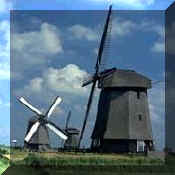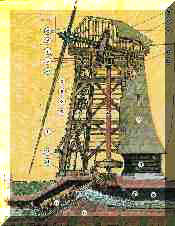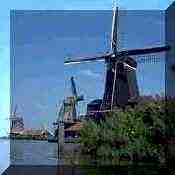Mills.
For
centuries the mill has symbolized the Dutch battle against the floods.
With
start of the 15th century in the west and north of the Netherlands take
works (poldermolen) were constructed in order to be able to control in
this manner the water levels in the Poldern.
In
the 17th century these mills were inserted then also to the reclaim the
inlands.
Examples
for that are the Schermer, the Beemster and the Purmer.
Yet
the mills were used not only to the control of the Dutch water household.
Mills
were inserted before that already also to industrial purposes.

Of
that once round it gives yet about 1.100 (1.035 windmill and 106 water
mill) at present to 10.000 mill that possessed Holland.
Therefrom
approximately 138 water mill stand be located in north-Holland, most
mill in the zone of the Schermer and the Zaanstreek.
The
Zaanstreek was stood was constructed one of the first industry regions
of the world, earlier here once einmal1.000 industry mill, a multitude
of this mill abgegrannt and never again, the by far largest part was
dismantled however.
Responsibly
for that the Siegeszug of the steam engine and other industrial
developments were.
Around
the year 1900 around van were that once 1.000 mill only yet few dozens
remaining. Today it only yet 12. under the industry mills it gave are
and mustard mill to oil -, paint -, paper - and grain.
Round
one-quarter of the mill (240) of the Zaanstreek were saw mill.

Museum
mill,
Noordervaart2 in Schermerhorn.
The
museum mill in Schermerhorn is egg ne real water mill and dates out of
the 17th century. The mill is always yet in operation and forms jointly
with two other mills a so-called "molengang". Van mill lain a
row next to one another becomes as a "molengang" designated.
These
mills are inserted then if the differences between the water levels are
so high, that these differences with an only Wasserhebemühle can no
longer be bridged.
Each
mill conveys the water respectively a level more highly.
This
system is designated also as a 'steps-take work".
In
the museum mill we the visitors shown how one lifted the water earlier
over four meter heights differences over the meal breast.
In
this mill, many information is given to the Dutch Polder and the roll,
that played the mill in this room.
The
ground of the mill consists of Glasplatten, through which the meal work
can be observed.
On
the storage, a reichbestückte collection is located van tools
dereinstigen mill farmer.

Zaanse Schans.
The
Zaanse Schans is the reconstruction of an old Zaanschen residential and
functioning quarter.
This
open-air museum comprises twenty houses, mill and pile houses out of
that 17th and 18th century.
Altogether
on the terrain nine, mills stand, under that the Olmühle "De
Zoeker" from the year 1673 and the windmill "De Kaf van 1782.
Each
hour discards an excursion boat to
einerVergnügungsfahrt

Zaans
museum
mill, Museumlaan 18 in Koog aan de Zaan
In
a walk distance to the Zaanse Schans, the Zaans Molenmuseum lies.
This
museum offers life of earlier an impression of such a mill to its
visitors.
Here
are also pressures, drawings and a model collection to besichtigen.
In
its monumental painting "Zaans Molenpanorama" (2 xs 12 meters)
schut of the painters Frans Mars an impressing work over the Zaanschen
mill industry.
Open
mill meets.
At
each second Saturday in the May the country expanse national mill days
takes place.
Then
more than open 600 winds and water mill in the entire country of the
interested public its gates.
At
this day become in many mills demonstrations of special geeze-work shown.
The
interested mills erken nt one at the blue pennant.
Beginning
of September takes place the Schermer
whirl day.
At
this day if possible many of the mill closed in the foundation Schermer
mill together are in operation.
Naturally
then also the museum mill in Schermerhorn be opened.
In
the zone of the Zaanstreek takes place at the last Saturday in the
September of the "Zaanse Molendag".
At
this day, many mills stand, under that the oldest papers wind mill of
the world, to the examination aften.
Mill-speaks.
In
earlier times the mill formed to a certain extent the midpoint of the
environment.
The
gauze instructed the persons over that, what happened in the village
partnership.
"Spoken
language" were certain positions of the mill wings in the
retirement.
There
there was a "vreugdestand" in the mills for example, literally
translates "bliss state".
In
correspondingly joyful events, it gave held stop a certain wing state,
with which the vertical standing wings stood then in that-position
"komende", i.e. the wings shortly before these the highest
point reached to the gauze.
The
vertical standing mill wing "gaande", i.e. shortly behind the
record level stopped, became pointed "rouwstand" signaling in
the sorrow this frequently at a death, that let mourn the gauze.
The
axes of the mill wings stood absolutely horizontally and vertically, the
gauze was shortly before that, to receive its work again.
A
quiet phase was on the other hand longer time, the mill wings in "X"
stood- form.
Mill-bicycle tour.
A
mill-bicycle tour passing over 40 km offers mill-bicycle tours of the
VVV Alkmaar.
This
tours proposal leads through 8 villages and to 14 mills.
The
VVV Zaandam more differently prepared three mills-bicycle tours.
The
shortest of the route leads at 13 mills past and is 29 km long.
The
62 km long route leads past at altogether 21 mills while the 90 km long
route to 37 mills leads.
Back
